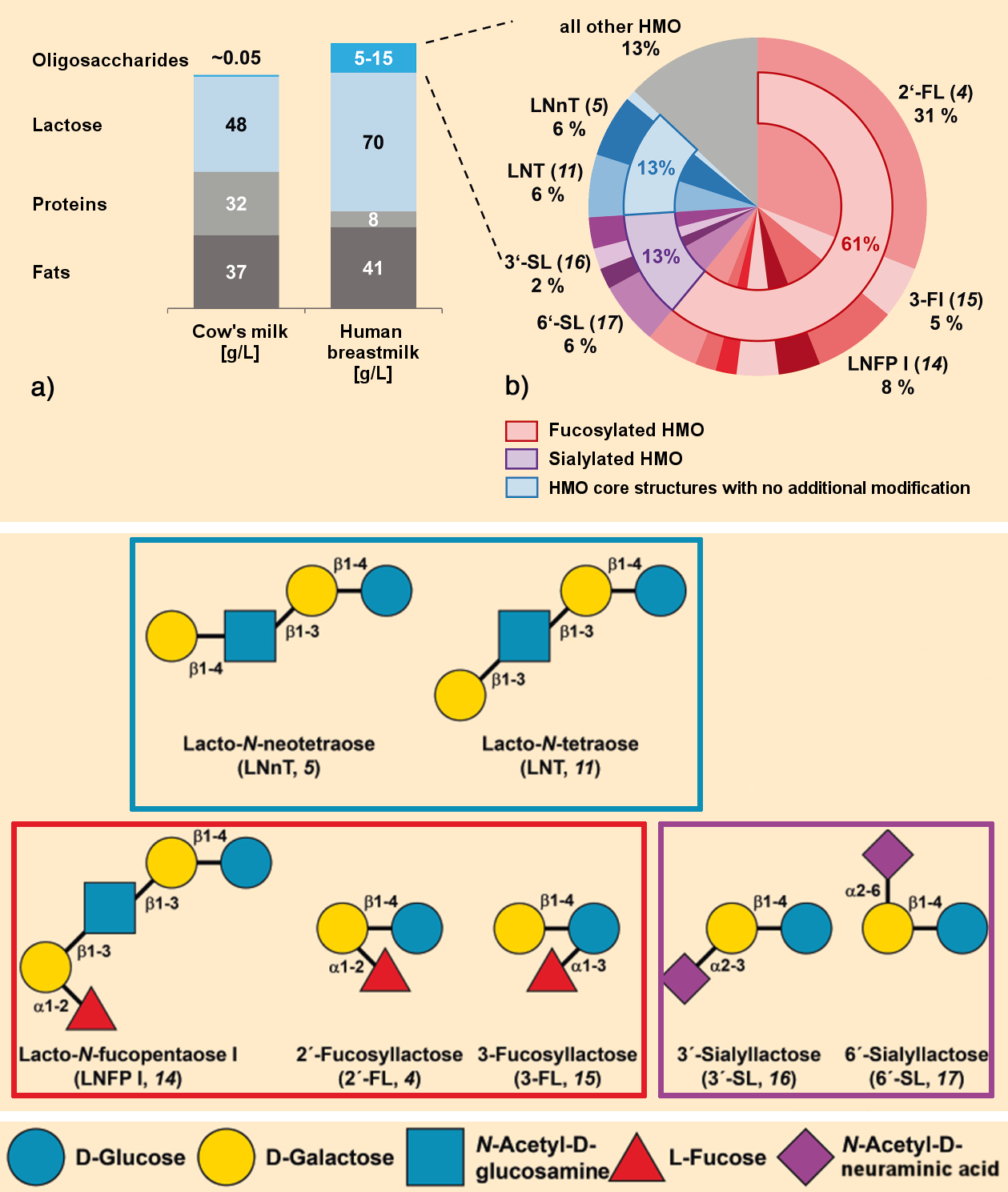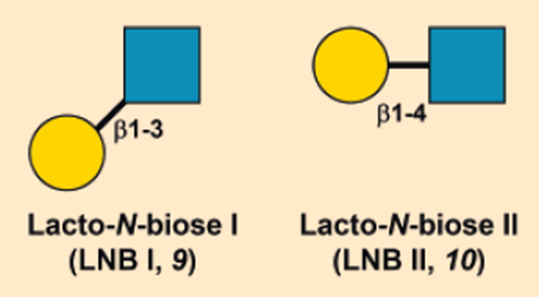Breast milk remains the “gold standard” of baby nutrition. In addition to water, lactose (which delivers energy), fats, and proteins, breast milk contains a number of other important components needed for the healthy development of an infant. One of these classes of biologically active substances is comprised of the human milk oligosaccharides (HMOs). In this part, we will take a closer look at the chemical structure of HMOs.
3. What are HMOs?
HMOs are structurally complex sugars that follow the general rules of sugar composition. Individual HMOs can include chains of up to 30 sugar units. To date, about 200 HMOs are known, of which about three quarters have been structurally characterized. Only a small number (<30) of these compounds have been produced synthetically [8]. Because every sugar contains multiple hydroxyl groups, it is a major challenge to link them selectively in synthetic processes.
The HMOs most frequently found in breast milk are depicted in Figure 1. They are largely subdivided into fucosylated and sialylated HMOs, in addition to HMO core structures without additional modifications. The mixture of HMOs varies from mother to mother, as well as over the course of the nursing period (see 2.1. Components of Breast Milk).
 |
|
Figure 1. Composition of human breast milk compared with cow’s milk [2]. |
.jpg) HMOs mostly consist of five monosaccharide building blocks (see Infobox 1). The general formula for HMOs is depicted in Figure 2 and includes a core structure made of the three monosaccharides D-glucose (Glc, 6), D-galactose (Gal, 7), and/or N-acetyl-D-glucosamine (GlcNAc, 8) [9]. One end of this structure is known as the reducing end, and usually consists of a lactose unit (a disaccharide containing Glc (6) and Gal (7); pictured on the right in Fig. 2). Two additional disaccharides are attached to the lactose (pictured on the left in Fig. 2). These can be repeating (n > 1) or single (n = 1).
HMOs mostly consist of five monosaccharide building blocks (see Infobox 1). The general formula for HMOs is depicted in Figure 2 and includes a core structure made of the three monosaccharides D-glucose (Glc, 6), D-galactose (Gal, 7), and/or N-acetyl-D-glucosamine (GlcNAc, 8) [9]. One end of this structure is known as the reducing end, and usually consists of a lactose unit (a disaccharide containing Glc (6) and Gal (7); pictured on the right in Fig. 2). Two additional disaccharides are attached to the lactose (pictured on the left in Fig. 2). These can be repeating (n > 1) or single (n = 1).
.jpg) |
|
Figure 2. General structure of human milk oligosaccharides (HMO) [9]. |
These disaccharides are lacto-N-biose I (LNB I, type I, 9) and lacto-N-biose II (LNB II, type II, 10) (see Fig. 3). The case when n = 1 gives the core structures LNT (11) and LNnT (5), which are among the HMOs most commonly found in breast milk (see Fig. 1).
 |
|
Figure 3. Disaccharides lacto-N-biose I (LNB I, type I, 9) and lacto-N-biose II (LNB II, type II, 10). |
These core sugar structures can be extended with the monosaccharide building blocks L-fucose (12) and N-acetyl-D-neuraminic acid (sialinic acid, 13) (pictured in red and purple in Fig. 2). These fucose and sialinic acid derivatizations make the HMOs resistant to digestion by human enzymes.
The simplest HMOs include the following trisaccharides (n = 0): the fucosylated lactoses 2′-FL (4) (the most abundant HMOs for most mothers) and 3-FL (15), as well as the sialylated lactoses 3′-SL (16) and 6′-SL (17).
4. Discovery and Initial Characterization of HMOs
The beginnings of HMO research are closely tied to the work of pediatricians, microbiologists, and chemists. A few early milestones include:
- the work of German-Austrian pediatrician Theodor Escherich (1857–1911), which is summarized in the monograph, “Enterobacteria of Infants and their Relation to the Physiology of Digestion”, published in 1886 [10],
- the independent observations of pediatricians Ernst Moro (1874–1951) and Henry Tissier of the unique predominance of bifidobacteria in the stool of nursing children [11–13],
- the recognition that the protein-free fraction of breast milk contains a heat-stable component (bifidus factor) that promotes the development of bifidus flora [1,3].
In the 19th century, in addition to the study of the physiological effects of breast milk and its carbohydrate fraction, scientists began to work on the identification, isolation, and structural characterization of oligosaccharides.
In 1888, Eschenbach was the first to note that human breast milk contains “a different type of lactose” from cow’s milk [1]. Shortly thereafter, G. Denigès discovered that human breastmilk contains an additional, unknown carbohydrate fraction [1]. More than 40 years later, around the year 1930, this fraction was characterized and called “gynolactose”. It is only slightly soluble in methanol and is comprised of nitrogen-containing hexoses (hexosamines) and other components [14,15].
In 1954, various research groups independently reached the conclusion that the “bifidus factor” and “gynolactose” were identical and that they consist of oligosaccharides [1,3]. This was a critical breakthrough in HMO research. Further study into the physiological effects of HMOs was carried out in the following years.
Because HMOs are so complex and numerous, with similar physicochemical properties, the isolation of individual HMOs and their structural characterization was not achieved until the 1950s in the work of Richard Kuhn. P. György, and Jean Montreuil [1]. By 1965, the first 14 structures had been determined, including 2′-FL (4), 3-fucosyllactose (3-FL, 15), lacto-N-tetraose (LNT, 11), 3′-sialyllactose (3′-SL, 16), and 6′-sialyllactose (6′-SL, 17) (see Fig. 1). Many others have followed [16].
References
[8] T. Nguyen, Synthesizing mothers’ milk – Scientists are seeking ways to make beneficial but elusive sugars found in breast milk, Chem. Eng. News 2018, 96, 26.
[9] G. A. Sprenger et al., Production of human milk oligosaccharides by enzymatic and whole-cell microbial biotransformations, J. Biotech. 2017, 258, 79–91. https://doi.org/10.1016/j.jbiotec.2017.07.030
[10] T. Escherich, Die Darmbakterien des Säuglings und ihre Beziehungen zur Physiologie der Verdauung (in German), hansebooks, Norderstedt, Germany, 2016. ISBN: 978-3-742-81348-0 (unchanged reprint of the original from 1886)
[11] H. Tissier, Recherches sur la Flora Intestinale Normale et Pathologique du Nourisson, Thesis, University of Paris, France, 1900.
[12] E. Moro, Über die nach Gram färbbaren Bacillen des Säuglingsstuhles (in German), Wien. Klin. Wochenschr. 1900, 13, 114–115.
[13] E. Moro, Morphologische und biologische Untersuchungen über die Darmbakterien des Säuglings (in German), Jahrb. Kinderheilk. 1905, 61, 687–734.
[14] M. Polonowski, A. Lespagnol, Sur deux nouveaux sucres du lait de femme, le gynolactose et l’allolactose (in French), C. R. Acad. Sci. 1931, 192, 1319–1320.
[15] M. Polonowski, A. Lespagnol, Sur la nature glucidique de la substance lévogyre du lait de Femme (in French), Bull. Soc. Biol. 1929, 101, 61–63.
[16] A. Kobata, Structures and application of oligosaccharides in human milk, Proc. Jpn. Acad. Ser. B Phys. Biol. Sci. 2010, 86, 731–747. https://doi.org/10.2183/pjab.86.731
The article has been published in German as:
- Mehr als 200 gute Gründe für das Stillen,
Michael Breuer, Melanie Weingarten,
Chem. unserer Zeit 2019, 53, 94–104.
https://doi.org/10.1002/ciuz.201900030
and was translated by Caroll Pohl-Ferry.
Nursing, Gut Bacteria, and the Immune System – Part 1
Which components are found in breast milk?
Nursing, Gut Bacteria, and the Immune System – Part 3
How are human milk oligosaccharides (HMO) synthesized?
Nursing, Gut Bacteria, and the Immune System – Part 4
Which effects do human milk oligosaccharides (HMO) have?
See similar articles published on ChemistryViews.org



